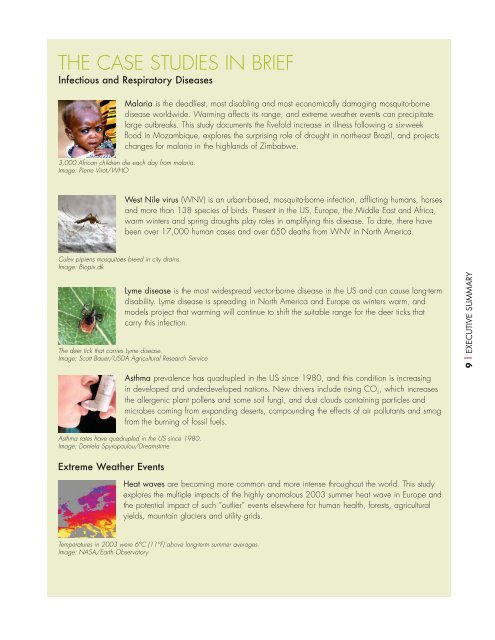Climate change futures: health, ecological and economic dimensions
Climate change futures: health, ecological and economic dimensions
Climate change futures: health, ecological and economic dimensions
You also want an ePaper? Increase the reach of your titles
YUMPU automatically turns print PDFs into web optimized ePapers that Google loves.
THE CASE STUDIES IN BRIEF<br />
Infectious <strong>and</strong> Respiratory Diseases<br />
Malaria is the deadliest, most disabling <strong>and</strong> most <strong>economic</strong>ally damaging mosquito-borne<br />
disease worldwide. Warming affects its range, <strong>and</strong> extreme weather events can precipitate<br />
large outbreaks. This study documents the fivefold increase in illness following a six-week<br />
flood in Mozambique, explores the surprising role of drought in northeast Brazil, <strong>and</strong> projects<br />
<strong>change</strong>s for malaria in the highl<strong>and</strong>s of Zimbabwe.<br />
3,000 African children die each day from malaria.<br />
Image: Pierre Virot/WHO<br />
West Nile virus (WNV) is an urban-based, mosquito-borne infection, afflicting humans, horses<br />
<strong>and</strong> more than 138 species of birds. Present in the US, Europe, the Middle East <strong>and</strong> Africa,<br />
warm winters <strong>and</strong> spring droughts play roles in amplifying this disease. To date, there have<br />
been over 17,000 human cases <strong>and</strong> over 650 deaths from WNV in North America.<br />
Culex pipiens mosquitoes breed in city drains.<br />
Image: Biopix.dk<br />
Lyme disease is the most widespread vector-borne disease in the US <strong>and</strong> can cause long-term<br />
disability. Lyme disease is spreading in North America <strong>and</strong> Europe as winters warm, <strong>and</strong><br />
models project that warming will continue to shift the suitable range for the deer ticks that<br />
carry this infection.<br />
The deer tick that carries Lyme disease.<br />
Image: Scott Bauer/USDA Agricultural Research Service<br />
9 | EXECUTIVE SUMMARY<br />
Asthma prevalence has quadrupled in the US since 1980, <strong>and</strong> this condition is increasing<br />
in developed <strong>and</strong> underdeveloped nations. New drivers include rising CO 2<br />
, which increases<br />
the allergenic plant pollens <strong>and</strong> some soil fungi, <strong>and</strong> dust clouds containing particles <strong>and</strong><br />
microbes coming from exp<strong>and</strong>ing deserts, compounding the effects of air pollutants <strong>and</strong> smog<br />
from the burning of fossil fuels.<br />
Asthma rates have quadrupled in the US since 1980.<br />
Image: Daniela Spyropoulou/Dreamstime<br />
Extreme Weather Events<br />
Heat waves are becoming more common <strong>and</strong> more intense throughout the world. This study<br />
explores the multiple impacts of the highly anomalous 2003 summer heat wave in Europe <strong>and</strong><br />
the potential impact of such “outlier” events elsewhere for human <strong>health</strong>, forests, agricultural<br />
yields, mountain glaciers <strong>and</strong> utility grids.<br />
Temperatures in 2003 were 6°C (11°F) above long-term summer averages.<br />
Image: NASA/Earth Observatory

















